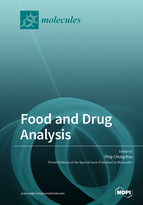Food and Drug Analysis
A special issue of Molecules (ISSN 1420-3049). This special issue belongs to the section "Natural Products Chemistry".
Deadline for manuscript submissions: closed (30 April 2020) | Viewed by 61481
Special Issue Editor
Special Issue Information
Dear Colleagues,
This Special Issue wishes to provide an intellectual platform for scientists to publish review, original research, short communication, etc., covering the topics of bioactive constituents, biological activities, and analytical methodologies in relation to food, drugs, and herbal medicines, as well as related disciplines of topical interest to public health.
Food and drug analysis includes the aspects of exploring natural sources as healthy food, characterizing the molecular structures of bioactive principles, identifying novel drugs, assessing their affinity and specificity, and examining their bioactivities in vitro and in vivo. In addition to extensively applied chromatographic methods, nuclear magnetic resonance (NMR) spectroscopy is also used in screening for novel bioactive molecules. Various new sample preparation methods have also been reported, especially for analysis in biological sample matrices, including LLE, SPE, and SPME. All these new analytical methods accelerate research and can make the potential targets available in the near future.
Prof. Ping-Chung Kuo
Guest Editor
Manuscript Submission Information
Manuscripts should be submitted online at www.mdpi.com by registering and logging in to this website. Once you are registered, click here to go to the submission form. Manuscripts can be submitted until the deadline. All submissions that pass pre-check are peer-reviewed. Accepted papers will be published continuously in the journal (as soon as accepted) and will be listed together on the special issue website. Research articles, review articles as well as short communications are invited. For planned papers, a title and short abstract (about 100 words) can be sent to the Editorial Office for announcement on this website.
Submitted manuscripts should not have been published previously, nor be under consideration for publication elsewhere (except conference proceedings papers). All manuscripts are thoroughly refereed through a single-blind peer-review process. A guide for authors and other relevant information for submission of manuscripts is available on the Instructions for Authors page. Molecules is an international peer-reviewed open access semimonthly journal published by MDPI.
Please visit the Instructions for Authors page before submitting a manuscript. The Article Processing Charge (APC) for publication in this open access journal is 2700 CHF (Swiss Francs). Submitted papers should be well formatted and use good English. Authors may use MDPI's English editing service prior to publication or during author revisions.
Keywords
- Bioactive constituent
- Biological activity
- Analytical methodology
- Sample preparation method
- Healthy food
- Drug and herbal medicine







